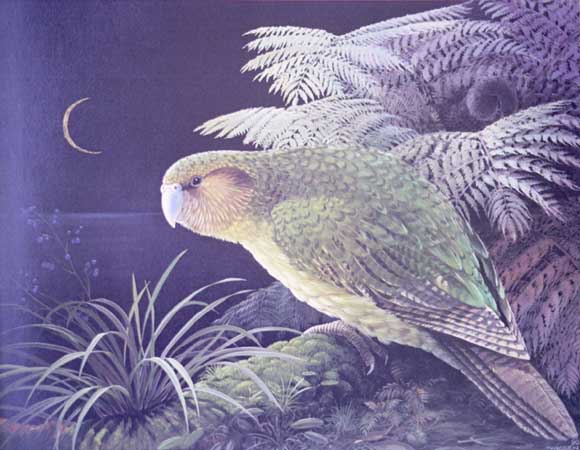I first heard about the plight of the kakapo parrot just recently, during a long winded but extremely interesting video segment of Douglas Adams. There are several interesting aspects about this bird, but the one that is intriguing me the most right now is the evolutionary biology angle.
Basically, the kakapo is a bird that missed the boat. It probably would have been driven to extinction if humans had not gotten involved and worked at bringing them back to higher numbers. What happened is that nature spoiled this great big bird initially, and the kakapo got so settled into its environment over the 70 million years that when its environment changed suddenly, it was unable to keep up.
For that long span of time, this parrot species native to New Zealand lived in an island environment with no predators or threats to their survival. Gradually, they had lost the ability to fly, as their body size increased, their wings got smaller, and they lost muscle and bone development in certain key areas. The adult males weigh up to 4 kg (which is 8 1/2 pounds), so they are a very large bird. They also developed a very slow breeding pattern, which would be a good evolutionary strategy for animals with a limited space and resources.
This 70 million year slow process, however, was interrupted in the late 1800s by the influx of Europeans to New Zealand. The colonists had brought domestic animals with them to this island, including cats, dogs, and stoats (which are cute little ferretlike animals with terrible fierce teeth that like to raid nests of birds and eat their eggs and young). Suddenly, there was survival pressure on this species that it just could not keep up with. When the colonists arrived, the joke was you “could shake a tree and the kakapo would fall like apples”. They were plentiful, and, as the native people before them, the colonists enjoyed eating the tasty plump white meat of this bird who could not get away fast enough. Feral cats and dogs, along with the stoats, did their damage as well, and by the 1890s, the population was in real trouble.
I would like to go into more detail about the stories of the attempts to bring the population of this bird up, which now hangs at about 122 individuals, and also some interesting reproductive aspects of this bird, but that is too much to go into detail with at this time. Expect more on the kakapo in the future.
